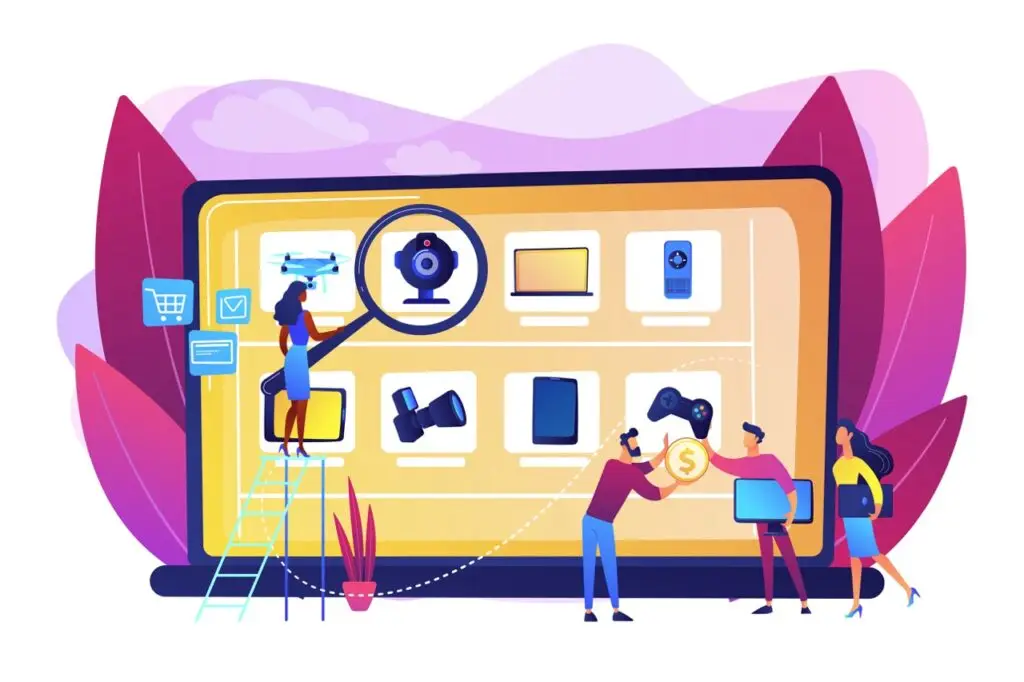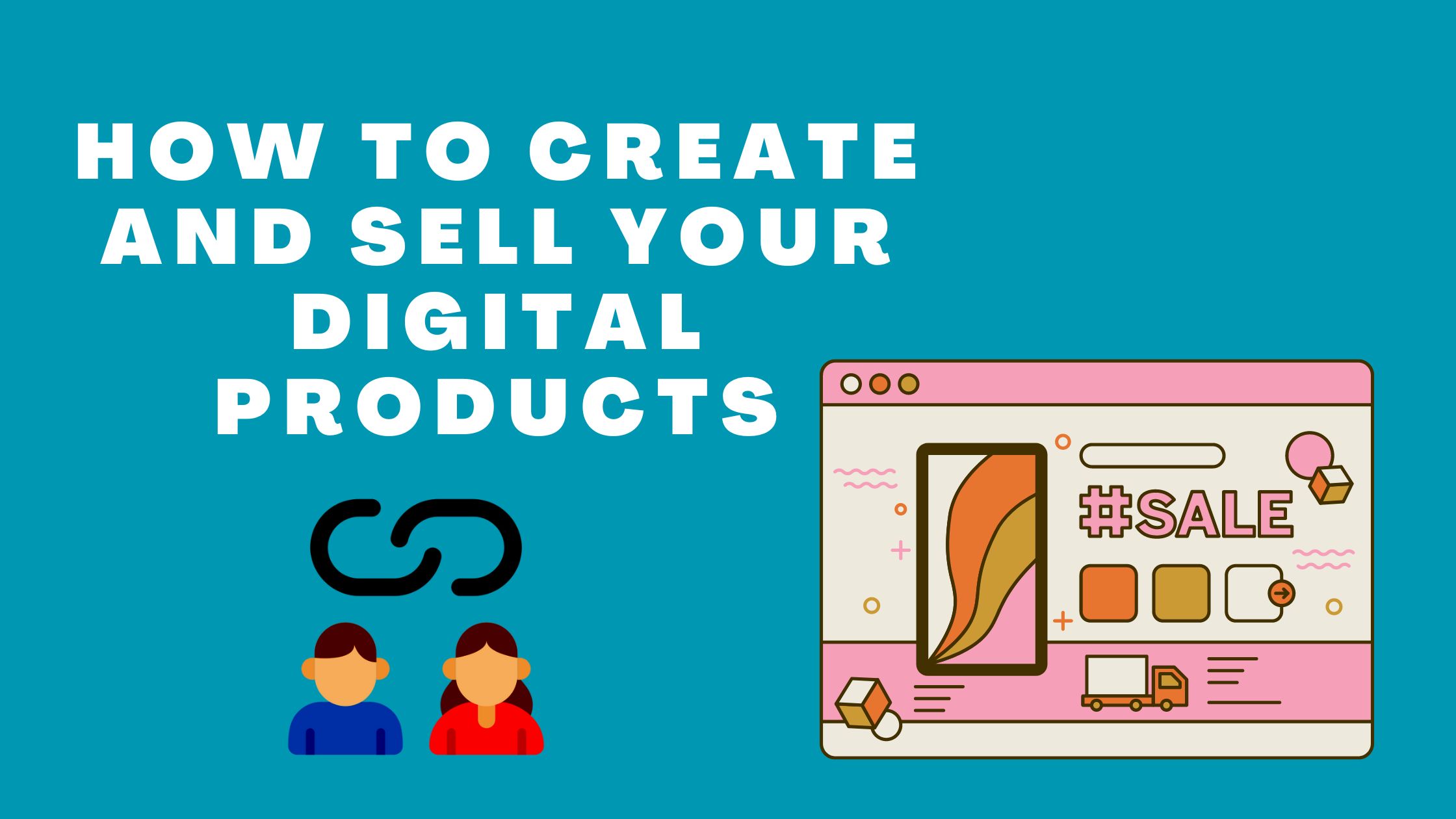In today’s digital age, selling digital products has become an increasingly popular way for individuals and businesses to generate income. Whether it’s an e-book, a course, or a software program, digital products can be created and sold from the comfort of your own home. Here are some steps to help you create and sell your digital products:
What are digital products?
Digital products are intangible goods that are created and distributed in digital forms, such as through the Internet or computer networks. They can be accessed, downloaded, or used on digital devices, such as computers, smartphones, or tablets. Examples of digital products include e-books, digital art, music, software, online courses, video games, and many others.
Digital products have become increasingly popular in recent years, as they are convenient, cost-effective, and easily accessible to a wide audience. They can be created and distributed without the need for physical production or shipping, making them a popular option for entrepreneurs and small businesses looking to generate income online.
How do I make and sell digital products?

- Identify your audience: Before creating a product, you need to know who you are creating it for. Identify your target audience and understand their needs and preferences. This will help you create a product that meets their requirements and is likely to sell. To do this, you can conduct market research, analyze data, and engage with your potential customers through surveys or focus groups.
- Choose a profitable niche: Once you have identified your target audience, the next step is to choose a profitable niche. This means finding an area where there is a demand for your product and little competition. You can use tools like Google Trends or Amazon Best Sellers to research popular niches and see what people are buying.
Recommended: Ways to make money online
- Create your product: With your niche and audience in mind, it’s time to create your digital product. Depending on your expertise and the niche you have chosen, you can create an e-book, an online course, a software program, or any other digital product that will provide value to your customers. You can use a variety of tools and software to create your product, such as Microsoft Office, Canva, or Teachable.
- Price your product: Pricing your product correctly is important for generating sales and revenue. Research the prices of similar products in your niche and aim to offer a competitive price. You can also offer discounts or promotions to incentivize customers to buy your product.
- Set up a sales page: To sell your product, you need to create a sales page that showcases the benefits of your product and encourages customers to make a purchase. You can use platforms like WordPress or Shopify to create a sales page or hire a web designer to do it for you.
- Drive traffic to your sales page: Once your sales page is set up, you need to drive traffic to it. This can be done through various marketing channels, such as social media, email marketing, or paid advertising. You can also collaborate with influencers or offer affiliate marketing programs to promote your product.
- Launch your product: Finally, it’s time to launch your product. This can be done through a soft launch to a small group of customers or a full-scale launch with a promotional campaign. Monitor your sales and customer feedback, and make adjustments to your product or marketing strategy as needed.
Read This: What is affiliate marketing and how to get started?
- Optimize your sales funnel: To increase your sales, it’s important to optimize your sales funnel. This means improving the customer journey from the point of awareness to the point of purchase. You can use analytics and data to identify areas where customers drop off or abandon their purchases. And make improvements to your sales page or marketing strategy to address these issues.
- Provide excellent customer support: Customer support is an essential part of any business, and it’s no different when selling digital products. Make sure to provide excellent customer support to your customers, such as offering a help desk or email support. This will help to build trust with your customers and encourage repeat business.
- Keep updating and improving your product: Finally, it’s important to keep updating and improving your product. Listen to customer feedback and make improvements based on their suggestions. This will help to keep your product relevant and valuable to your customers and encourage repeat business and positive reviews.
Where to sell digital products for free

There are several online platforms where you can sell digital products for free. Here are a few options to consider:
- Gumroad: Gumroad is a popular platform for selling digital products, including ebooks, music, videos, and software. The platform allows you to create a customizable storefront, set your prices, and accept payments from a variety of sources. Gumroad takes a small commission on each sale, but there are no upfront fees to use the platform.
- Payhip: Payhip is a platform that allows you to sell digital products, such as ebooks, music, and software, directly to your audience. The platform offers a variety of tools to help you create and market your products. Including customizable landing pages and email marketing tools. Payhip takes a small commission on each sale, but there are no upfront fees to use the platform.
- Selz: Selz is a platform that allows you to sell digital products, as well as physical products, online. The platform offers a variety of features to help you create and market your products. Including customizable storefronts, email marketing tools, and built-in payment processing. Selz takes a small commission on each sale, but there are no upfront fees to use the platform.
Recommended: A Beginner’s Guide to Web Hosting
- Etsy: While known primarily as a marketplace for handmade and vintage items. Etsy also allows sellers to offer digital products for sale, such as printables and digital art. The platform takes a small commission on each sale, but there are no upfront fees to use the platform.
- itch.io: If you’re selling digital products related to gaming or software development, itch.io is a platform to consider. The platform allows you to sell games, software, and other digital products, with a customizable storefront and a variety of payment options. itch.io takes a small commission on each sale, but there are no upfront fees to use the platform.
These are just a few of the many platforms available for selling digital products. Be sure to review the features and pricing of each platform to find the one that best meets your needs.
Can I make money selling digital products?
Yes, you can make money selling digital products. Digital products can be a profitable and flexible source of income, as they can be created and sold from anywhere in the world, and the costs of production and distribution are often low. Digital products also have the potential to reach a global audience, allowing you to tap into a larger market.
However, like any business, making money selling digital products requires effort, time, and strategic planning. You need to create a product that provides value to your customers and meets their needs. You need to market your product effectively to reach your target audience. You also need to price your product competitively, and continually improve and update your product based on customer feedback.
If you’re willing to put in the effort and create a quality digital product, there’s a good chance you can make money selling it. You can also explore different monetization models, such as subscription-based or one-time sales, or offering upsells and additional products or services to increase revenue. Just remember that success in selling digital products often comes down to providing value to your customers, so focus on creating a high-quality product and delivering excellent customer service.
What is the most profitable digital product?
The most profitable digital product depends on various factors, such as your target audience, the demand for the product, and the pricing strategy. Here are some examples of profitable digital products:
- E-books: E-books are popular and profitable digital products. They can cover a wide range of topics and can be priced relatively high.
- Online courses: Online courses are in high demand, especially in industries like business, technology, and personal development. They can be priced at a premium and can provide ongoing revenue through subscriptions or memberships.
- Digital art: Digital art, such as stock photos or graphic designs, can be sold multiple times, making it a profitable and scalable product.
- Software and apps: Software and apps can be profitable if they solve a problem or provide a unique value proposition to their users.
- Music and audio files: Music and audio files, such as beats, sound effects, and jingles, can be sold to content creators, filmmakers, and game developers.
Ultimately, the most profitable digital product for you will depend on your skills, interests, and audience. It’s important to do your research and identify a profitable niche where you can create a product that provides value to your customers.
What products are in very high demand?
Many products are in very high demand in today’s market, both in the digital and physical realms. Here are a few examples:
- Health and wellness products: With the ongoing pandemic and an increasing focus on self-care, products related to health and wellness are in high demand. This includes things like supplements, fitness equipment, and healthy food options.
- Technology products: Technology continues to be in high demand, with consumers looking for the latest gadgets, software, and apps. This includes smartphones, laptops, gaming consoles, and smart home devices.
- Home improvement and DIY products: With many people spending more time at home, there is a growing demand for products related to home improvement and DIY projects. This includes tools, materials, and tutorials for home renovation and repair.
- Sustainable and eco-friendly products: There is a growing interest in sustainable and eco-friendly products, with consumers looking for environmentally conscious options for everything from household products to fashion.
- Entertainment and media products: With more people spending time at home, products related to entertainment and media are also in high demand. This includes video games, streaming services, and digital media products like e-books and online courses.
Of course, the most in-demand products will vary based on several factors, such as current events, trends, and the needs of the specific audience. It’s important to do your research and stay up-to-date with market trends to identify the most profitable product opportunities.
Is it legal to resell digital products?
The legality of reselling digital products can be a complex issue and varies depending on the specific product. The country you are operating in, and the terms of the license agreement that governs the use of the product. In general, the law regarding reselling digital products is not as clear as it is for physical products.
For example, some digital products like e-books, music, and software come with specific license agreements. That limits the purchaser’s right to resell or transfer the product. In such cases, reselling these products without permission may be considered copyright infringement and may lead to legal consequences.
However, some digital products can be resold legally, such as digital art, stock photos, and certain types of domain names. It’s important to carefully review the license agreements and terms of use for any digital product. You plan to resell to ensure that you are not infringing on any copyright or intellectual property rights.
If you are unsure about the legality of reselling a specific digital product. It’s best to seek the advice of a legal professional who can help you navigate the relevant laws and regulations.
Why do digital products fail?
Digital products can fail for a variety of reasons. Here are a few common reasons why digital products may not succeed:
- Lack of market research: If you don’t have a clear understanding of your target audience and their needs. It’s unlikely that your digital product will resonate with them.
- Poor quality: Digital products need to provide value to the customer, and if the product is of low quality or doesn’t meet the customer’s expectations, it’s unlikely to succeed.
- Insufficient marketing: Even the best digital product won’t sell if it’s not marketed effectively. A lack of marketing or promotion can make it difficult for potential customers to find your product.
- Uncompetitive pricing: Digital products that are priced too high or too low can also fail. If the price is too high, customers may be reluctant to purchase the product. And if the price is too low, it may be perceived as low quality or not providing enough value.
- Lack of ongoing development: Digital products that are not updated or improved over time can become outdated or irrelevant, causing them to lose their appeal to customers.
- Inadequate customer support: Digital products need to be supported with good customer service and support. If customers have a bad experience with customer support. It can damage the reputation of the product and make it difficult to retain customers.
Ultimately, digital products require ongoing effort and attention to succeed. It’s important to listen to customer feedback. Continually improve and update your product, and actively promote and market it to reach a wider audience.
Is it better to sell physical or digital products?
Deciding whether to sell physical or digital products depends on a variety of factors. Including your business model, target audience, and the specific products you are selling. Here are a few things to consider when deciding between physical and digital products:
- Cost: One of the advantages of digital products is that they often have a lower cost of production. And distribution than physical products, which can make them more profitable in the long run. However, there may be additional costs associated with creating or hosting digital products. Such as web hosting fees or software development costs.
- Accessibility: Digital products are often more accessible to customers than physical products. As they can be purchased and downloaded instantly from anywhere with an internet connection. This can make them an attractive option for customers who are looking for convenience and instant gratification.
Recommended: How to start a profitable blog and monetize it
- Perceived value: Depending on your target audience, physical products may be perceived as having a higher value than digital products. This can be particularly true for products like luxury goods, where the physical product itself is a status symbol.
- Competition: The market for digital products can be very crowded, with many competitors vying for attention. Physical products may face less competition, particularly if you are targeting a niche market or creating a unique product.
- Customer preferences: Ultimately, the decision to sell physical or digital products may come down to the preferences of your target audience. If your customers prefer physical products, then it may be more advantageous to focus on creating and selling physical goods. However, if your customers are more digitally-focused, then digital products may be the better option.
In general, both physical and digital products can be successful. Depending on the specifics of your business and the products you are selling. It’s important to carefully consider the advantages and disadvantages of each before making a decision.
What are the problems of digital marketing?
Digital marketing can be a very effective way to promote products and services, but it is not without its challenges. Here are a few common problems that businesses may face when engaging in digital marketing:
- Information overload: With so much content available online, it can be difficult to cut through the noise and reach your target audience. Businesses may struggle to create content that is engaging and impactful enough to capture the attention of potential customers.
- Ad fraud and ad blockers: Ad fraud and ad blockers can be a significant challenge for businesses engaging in digital advertising. Ad fraud refers to fraudulent activity designed to generate clicks or views on ads, while ad blockers prevent ads from being displayed to users. This can make it difficult to reach your target audience and generate meaningful leads.
- Rapidly changing technology: Digital marketing technology is constantly evolving, and businesses may struggle to keep up with the latest trends and tools. This can be particularly challenging for smaller businesses with limited resources and expertise.
- Privacy concerns: As consumers become more aware of privacy concerns, they may be less likely to share personal information online or engage with digital marketing efforts that they perceive as invasive or intrusive.
Read This: Choosing the Right Web Hosting Plan for Your Website
- Competition: The online marketplace can be very competitive, with many businesses vying for attention and market share. Businesses may struggle to stand out and differentiate themselves from their competitors, particularly if they are operating in a crowded market.
- Measuring ROI: Measuring the return on investment (ROI) of digital marketing efforts can be challenging, particularly if businesses are using multiple channels and tactics to reach their audience. It can be difficult to accurately track and attribute leads and sales to specific marketing campaigns, which can make it challenging to optimize marketing efforts and allocate resources effectively.
Despite these challenges, digital marketing can be a powerful tool for businesses looking to reach new audiences and promote their products and services. By understanding the potential obstacles and developing effective strategies to overcome them, businesses can effectively navigate the complex digital marketing landscape and achieve their marketing goals.
Conclusion!
In summary, creating and selling digital products can be a lucrative and rewarding way to generate income. By identifying your target audience, choosing a profitable niche, creating a valuable product, and marketing it effectively, you can build a successful business selling digital products. Just remember to prioritize customer support and keep improving your product to ensure long-term success.





